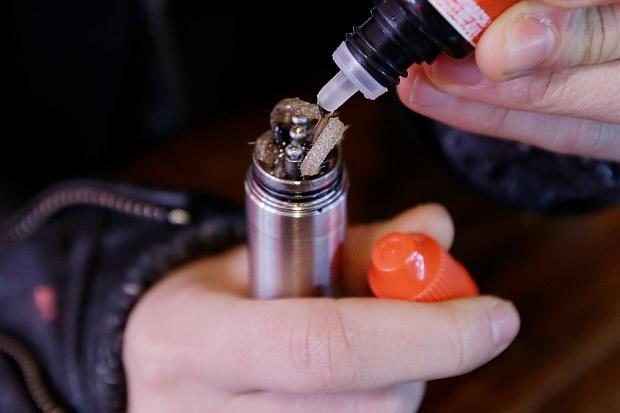Nicotine-free vapes can damage lungs–study
Researchers at Anglia Ruskin University in the UK have found that nicotine-free vapes contain a protein that could damage lung tissue. Vaping is seen as a popular alternative to smoking, offering a way for smokers to maintain their habit without the nicotine. However, these vapes are rich in the ARF6 protein, which is associated with lung tissue harm.
More people are vaping instead of smoking nowadays. The young see it as a cooler alternative than lighting cigarettes, and the old view it as a way to quit a vice. Yet, it’s important to recognize the risks associated with vape sticks. This discovery opens the door to potentially developing safer vaping options and finding more effective ways to quit smoking.
What is the risk of nicotine-free vapes?

Experts from the United Kingdom studied how a popular brand of nicotine-free e-cigarettes impacted human lung tissue cells. Their laboratory findings indicate that they can cause oxidative stress despite the lack of nicotine.
The latter is the addictive, poisonous substance found in cigarettes that causes such symptoms. ScienceAlert says oxidative stress is a cell’s natural reaction to become imbalanced, causing it to malfunction.
The researchers observed this reaction occurred with increased inflammation and blood vessel breakdown. Worse, a combination of these symptoms often indicates lung injuries.
“Nicotine-free vape fluid has been demonstrated to have the same chemical composition as nicotine-containing fluid except for the absence of nicotine,” says biomedical scientist Havovi Chichger.
You may also like: 3D printing hair and skin is now possible
“Our findings indicate that nicotine-free vape fluid exposure causes similar pro-oxidant and pro-inflammatory effects on human microvascular endothelial cells,” she adds.
Later, she and her colleagues repeated the test with the same brand containing nicotine. Surprisingly, the absence of the addictive substance did not render them safer than their nicotine-free counterparts.
They identified the abundance of the ARF6 protein in nicotine-free vapes, which seemed to cause lung tissue damage. Ironically, it also ensures the body’s blood vessels function properly. That is why the researchers are investigating ARF6 and nicotine-free e-cigarettes further.
How do e-cigarettes work?
Let’s discuss what vapes are to further explain the nicotine-free ones. We’ll use data from one of my past articles from Inquirer USA. These portable battery-powered devices evaporate various liquids into vapors that are supposedly safer than smoking.
They come in strangely sweet-smelling scents like strawberry and coffee. Also, you could purchase disposable ones from your local convenience store or grab more expensive, refillable kits.
However, some contain acrolein and formaldehyde that causes irreversible lung damage. Moreover, these may include nicotine and artificial flavors like the one mentioned above.
You may also like: How to stay safe in poor air quality
The pen heats that mixture into an aerosol vapor that a user inhales into his lungs. Nowadays, you can buy various types of electronic cigarettes.
Minis resemble regular cigarettes, and they are disposable. Closed-pod e-cigs are disposable vape pens that contain a liquid pod. You could replace the pod with a new one once it runs out.
Refillable systems have a tank that can contain the vape liquid or juice you want. Unlike closed pods, you simply pour new liquid into the tank.
Does vaping cause pimples?
The vape liquid ingredients could dry your throat and mouth. These could also dry your skin and deprive it of antioxidants, increasing the amount of sebum.
It is the oil that your skin uses to stay hydrated. However, too much sebum could cause pimples in blocked skin pores. In other words, vaping could cause zit breakouts.
Various studies have shown that smoking could cause acne after puberty. Since smoking and vaping contain nicotine, some experts agree that the latter could cause pimples.
Vaping could harm your skin in other ways. For example, it could increase the chances of facial scarring. Nicotine harms immune cells that are essential for repairing the skin.
As a result, smoking and vaping can delay wound healing. Pop those zits, and they could take longer to heal and may leave gross marks on your face.
You may also like: Scientists create a super waterproof material
Nicotine could also make you look older by giving you wrinkles. It narrows your blood vessels, preventing them from giving oxygen and nutrients to your skin cells.
Eventually, your skin will struggle to survive. As a result, you are more likely to have a “smoker’s face,” a condition where your face looks older than your current age.
You may also develop skin rashes as you vape. E-cigarettes use nickel to heat vape liquid, seeping into your lips and smoking hand.
Conclusion
Anglia Ruskin University experts discovered that nicotine-free vapes can still harm health. Specifically, they contain a specific protein that can still damage the lungs.
“Vaping is a significant health concern considering the rising numbers of smokers, especially young teenagers, and research into its health impact is still at an early stage,” Havovi Chichger warns. That is why she and her colleagues continue their research.
Learn more about this study on nicotine-free vapes on the Anglia Ruskin University website. Also, check the latest digital tips and trends at Inquirer Tech.